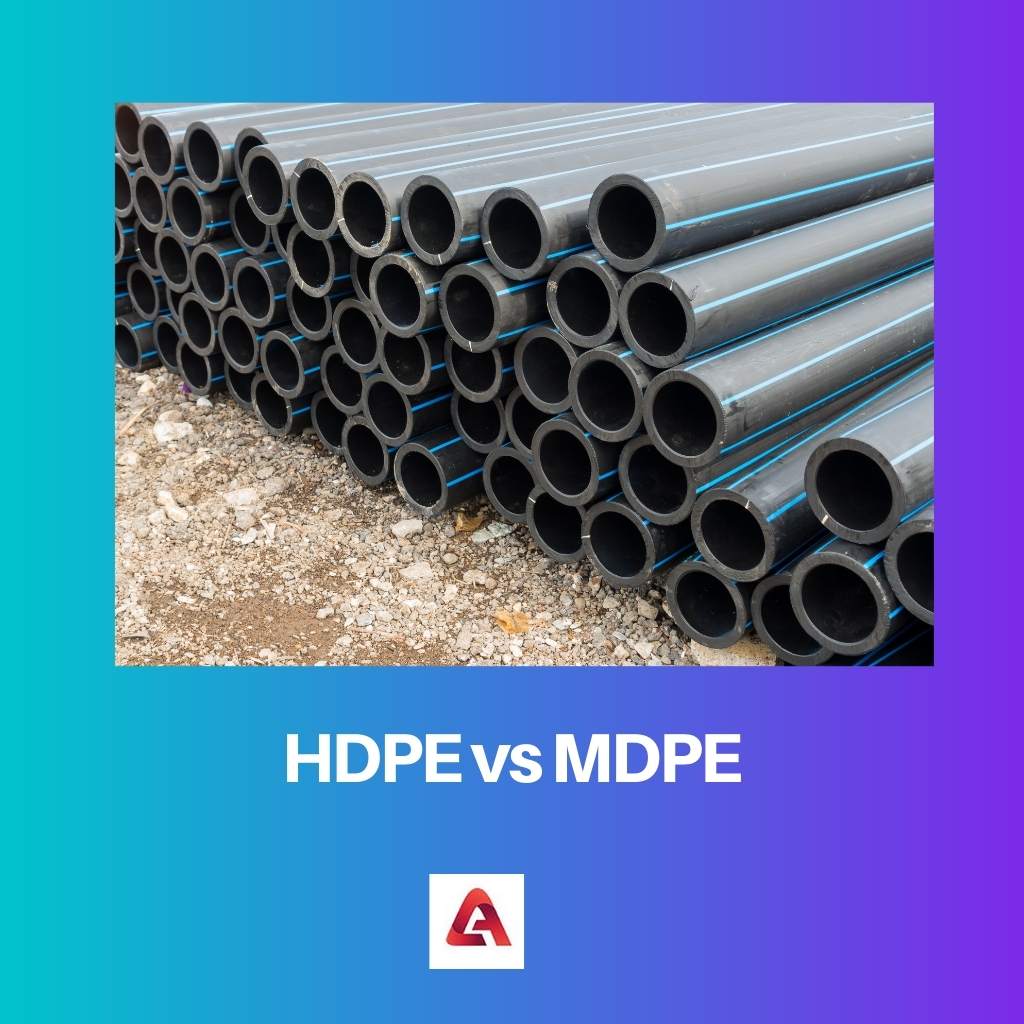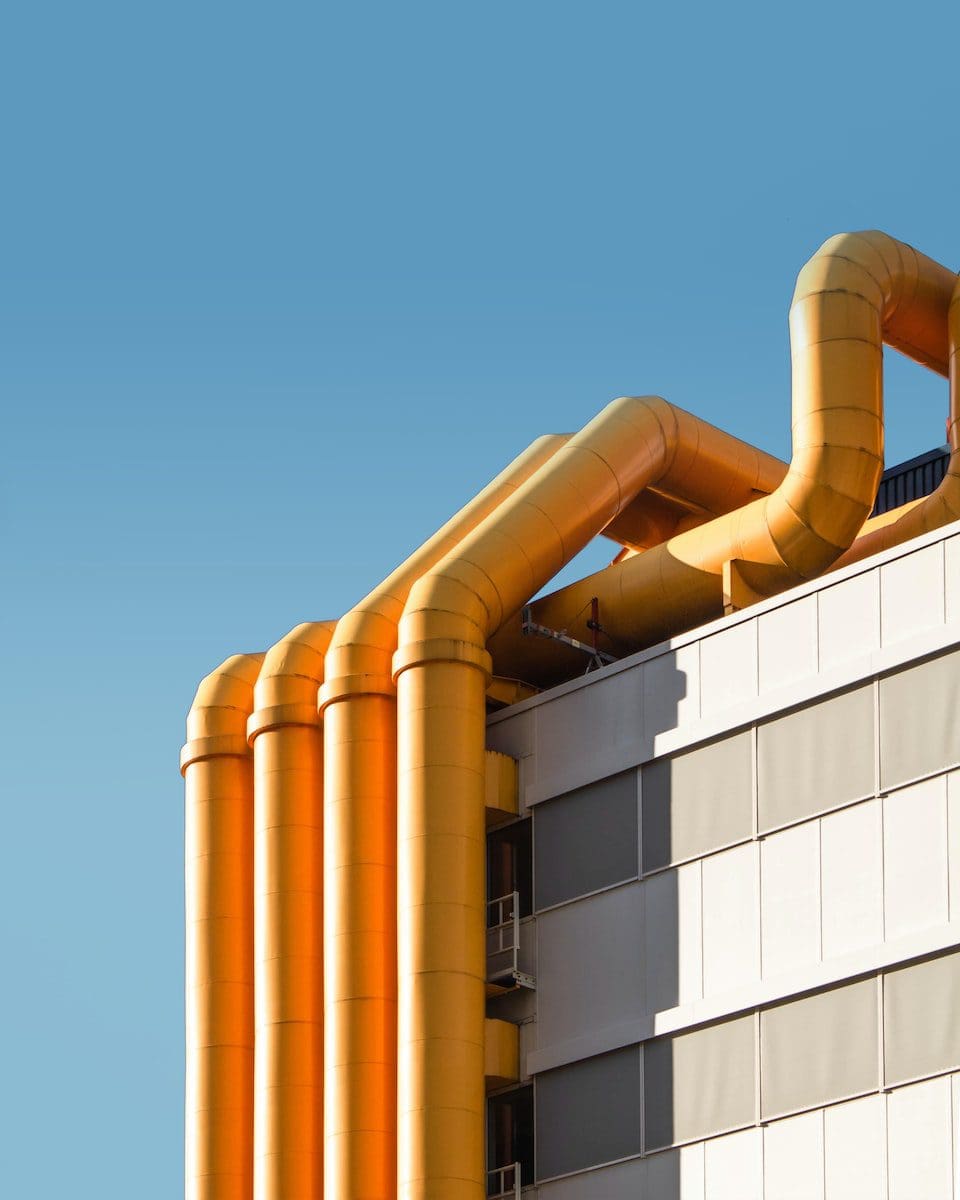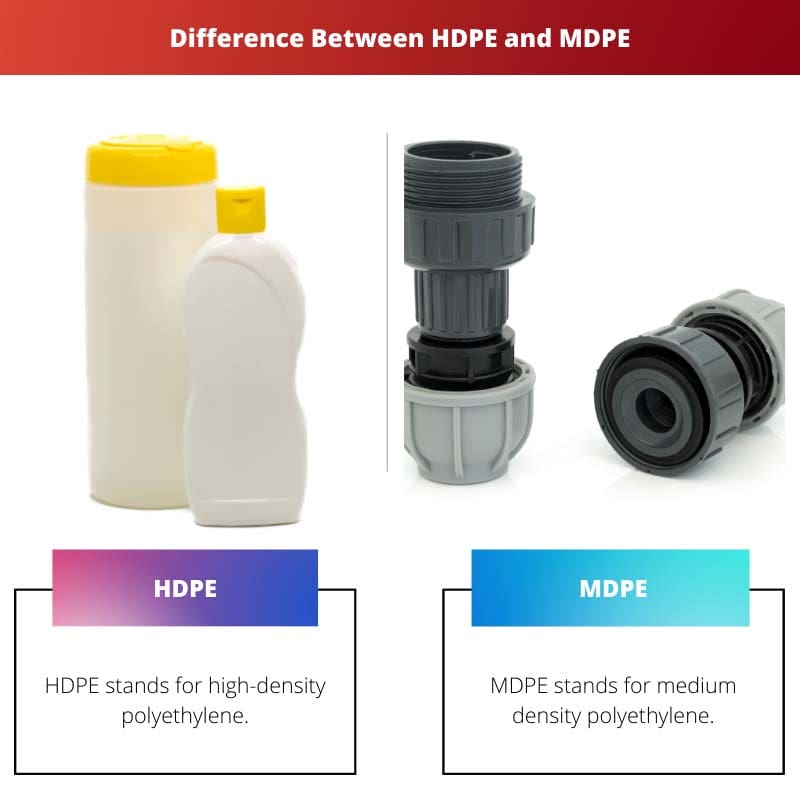Polyethene is a polymer of ethylene, and it has two categories. One is HPDE, and the other is MPDE. Polyethene is also called polythene.
This thermoplastic polymer is mainly used in industries to manufacture packaging materials, plastic bags, and so on. Polythene, when formed by combining ethylene monomers, forms a long chain with different densities.
Key Takeaways
- HDPE stands for High-Density Polyethylene, while MDPE stands for Medium-Density Polyethylene.
- HDPE has a higher density and is stronger, more rigid, and more resistant to heat and chemicals than MDPE.
- MDPE, on the other hand, is more flexible and has better impact resistance than HDPE.
HDPE vs MDPE
High-Density Polyethylene (HDPE) is a type of polyethene with a high strength-to-density ratio used in products like containers and pipes due to its high resistance to impact and weather. Medium-Density Polyethylene (MDPE) is a type of polyethene with properties that fall between HDPE and LDPE, commonly used in gas pipes and fittings.

HPDE is high-density polyethene. It has a higher density and thus its name. It has a density of about 0.941 g/cm3 or even higher than this value.
HPDE has a strong and powerful intermolecular force and also a very high tensility. Its tensile strength is because of the lower degree of ranching. The branching can be further lowered using catalysts.
MDPE stands for medium-density polyethene. It has a medium density due to the name 0.926 to 0.940 gm/am3 for the manufacture of this polymer chromium catalysts, silica catalysts, and others like Ziegler – Natta and metallocene catalysts.
It has good chemical resistance and has high stability at room temperature.
Comparison Table
| Parameters of Comparison | HDPE | MDPE |
|---|---|---|
| Full-Form | HDPE stands for high-density polyethylene. | MDPE stands for medium density polyethylene. |
| Density | HDPE has a high density of about 0.914g/cm3. | MDPE has a low density of about 0.926 to 0.940 gm/am3. |
| Sensitivity | HDPE is highly sensitive. | MDPE is comparatively less sensitive. |
| Stress Cracking Resistance | HDPE has low resistance to stress cracking. | MDPE has a higher resistance to stress cracking. |
| Branching | HDPE has the most minimal branching. | MDPE has minimum branching, too, but a little higher than HDPE. |
What is HDPE?
HDPE is known for its high strength density ratio, which is about 930 to 970 kg/m3. The density of HDPE is only marginally greater than LDPE. It also has strong intermolecular forces. It has high tensile strength.
It is harder and opaque in nature. The physical properties depend more on the type of catalysts used. It cannot be glued as it is not soluble in solvents.
It is used in many areas, like banners, boats, bottle caps, and fireworks. It is used in a lot of places. It is also of graded quality to perform plastic surgeries. This hydrocarbon polymer is prepared from ethylene or also from petroleum.
It is thermoplastic and can withstand high temperatures. It is easy to mould and weld and is found in many applications. It can be used in several places, and thus it is such a boon.
It has lightweight and it is strong. It is impact resistant and does not get damaged easily. It is also extremely resistant to bad and extreme weather conditions.
It can also withstand mould, mildew, rotting, and insects and can be used in underground pipes. It is an extremely good alternative for heavy materials.

What is MDPE?
MDPE is also a thermoplastic prepared by applying low pressure with the help of transition metal catalysts like metallocene catalysts. It is comparatively less opaque when compared with HDPE.
It is extremely crack resistant but less rigid and hard. It is less expensive and easily affordable. It is flexible and thus used in manufacturing bags. This is stronger but not tough enough.
This is produced on a smaller scale when compared with other density polyethene. It is both stiff as well as flexible at the same time. It has less chemical resistance and is rigid.
It is used to manufacture pipes due to its favourable mechanical qualities like high ductility, impact strength, and low friction. It has favourable properties that make it suitable for a lot of commercial applications.
It is resistant to both acid and base and also resistant to oxidants and reducing agents. There is a high demand in the market for this thermoplastic due to its good quality, affordable price, and also sue to its favourable mechanical properties.
Gas pipes, water, waste, and sewage are carried through the pipes of MDPE polymers. It is also used in agriculture due to its flexibility and easiness.
It takes less time and less effort to manufacture, and hence it is easy to manufacture. The biggest advantage is that it is nontoxic, nonhazardous, and extremely safe.
It has high impact-resistant properties and resistance to moisture and chemicals. It is recyclable, which is one of the best qualities that makes this so popular. These are also used in automobile applications.

Main Differences Between HDPE and MDPE
- HDPE is high-density polyethene, whereas MDPE is medium-density polyethene.
- As the name suggests, HDPE has a higher density when compared with MDPE.
- HDPE is more sensitive than MDPE.
- HDPE is less resistant to stress cracking, whereas MDPE is more resistant.
- HDPE has minimum branching, and MDPE, though it has a minimum branching, is slightly higher than that of HDPE.

- https://www.sciencedirect.com/science/article/pii/S221478531933295X
- https://www.sciencedirect.com/science/article/pii/S0261306912008321

The article presents a comprehensive overview of HDPE and MDPE, elucidating their properties, applications, and production processes with great clarity.
I found the detailed explanations of HDPE’s resistance to impact and weather and MDPE’s mechanical qualities to be particularly insightful and educational.
The article provides a clear and concise comparison between HDPE and MDPE, outlining the key differences and properties of both polymers.
I completely agree, the article is very informative and well-written.
The article delves into the production process, properties, and commercial applications of HDPE and MDPE, providing a comprehensive overview of these thermoplastics.
I found the detailed descriptions of HDPE and MDPE very enlightening. It’s great to see such a thorough analysis of these polymers.
The comparison of branching and resistance to stress cracking between HDPE and MDPE was particularly informative and valuable.
The article effectively communicates the distinct characteristics and practical uses of HDPE and MDPE, making it an invaluable resource for individuals interested in these polymers.
I agree, the article’s detailed comparison of HDPE and MDPE enhances readers’ understanding of their unique properties and applications.
The article aptly distinguishes the properties and applications of HDPE and MDPE, providing readers with a thorough understanding of these polymers.
I completely agree, the in-depth analysis of HDPE and MDPE makes this article an excellent reference for those seeking knowledge about these thermoplastics.
The article effectively outlines the physical and chemical properties of HDPE and MDPE, providing a well-rounded understanding of their characteristics.
Yes, the article provides a detailed insight into the unique qualities of HDPE and MDPE, making it an excellent resource for anyone interested in these polymers.
The in-depth analysis of HDPE and MDPE provides readers with a comprehensive understanding of their properties, production processes, and applications.
The article’s detailed comparison table is especially helpful for distinguishing the characteristics and uses of HDPE and MDPE.
The detailed descriptions of the production methods, physical properties, and uses of HDPE and MDPE contribute to the comprehensive nature of the article.
I found the comparison between HDPE’s tensile strength and MDPE’s mechanical qualities to be particularly informative and thought-provoking.
The article’s explanation of HDPE’s resistance to extreme weather conditions and MDPE’s versatility in commercial applications is highly enlightening.
The author explains in detail the density, sensitivity, and stress cracking resistance of HDPE and MDPE, making it easy to understand their properties.
Yes, the table comparing the parameters of both polymers is particularly helpful for understanding the differences and applications of HDPE and MDPE.
The article’s explanation of the applications of HDPE and MDPE in various industries, such as packaging, gas pipes, and agriculture, is particularly informative and insightful.
I agree, the practical applications of HDPE and MDPE in different sectors are well elaborated, adding to the article’s richness of information.
The detailed comparison table highlighting the distinctive parameters of HDPE and MDPE adds significant value to the article, aiding in the comprehension of their differences.
Yes, the comparison table effectively summarizes the key differences and characteristics of HDPE and MDPE in a clear and organized manner.